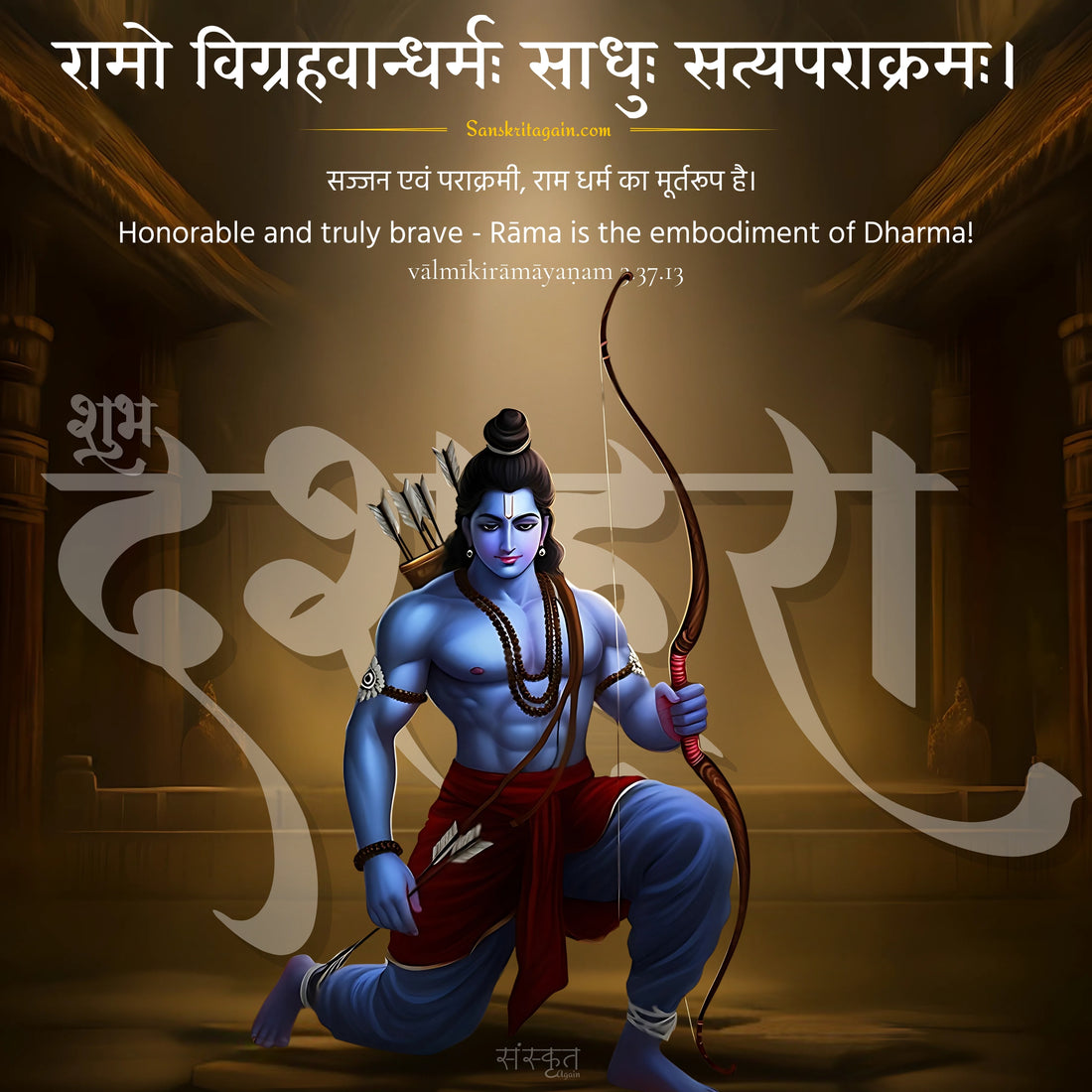
Dussehra : Vijaya Dashami, Legends, Significance, and Sanskrit Shloka
Share
Vijaya Daśami, also known as Dussehra, is one of the most significant festivals in the cultural tradition of India. This festival is observed on the tenth day of the bright fortnight after the culmination of Navarātrī and is considered an auspicious occasion to start any new venture or begin a new journey. It is called Dasha-hara or Dussehra in the north, Vijayadashami in the south, and Durgotsava in the east. The word Dashara is derived from two Sanskrit words – dasha (ten) and hara (defeat).
यतो धर्मस्ततो जयः।
Yato Dharmastato Jayaḥ
- महाभारत, भगवद् गीता
Hindi translation: जहाँ धर्म (अपने कर्तव्यों का पालन) है, वहाँ विजय है।
English translation: Where there is Dharma (performance of one's duties), there is victory.
The Significance of Vijaya Dashami
Vijaya Dashami marks the victory of divine power over demoniac forces. It was on this day that Lord Rāma killed the ten-headed Rāvana, who had abducted His wife Sītādevī, hence the name Dashara (दशहरा). It celebrates the day when righteousness triumphed over evil, symbolizing the ultimate victory of good. Rāvana’s ten heads represent ten negative qualities that need to be eliminated, and hence the burning of his effigy signifies the eradication of these negativities within ourselves. By shedding these negatives, our inner Divinity shines forth.
On Vijaya Dashami, we strive to remove all negativity and celebrate our inner triumph. This day reminds us of our inherent joy and purity, reminiscent of our childhood. It is a time for rejuvenating our spirit, clearing away accumulated negativities, and embracing a life of celebration and enlightenment.
Why We Celebrate Dussehra: Legends Associated with the Festival
The festival of Dussehra has its origins in the great Hindu epic Ramayana, which states that Lord Rāma, the eighth avatar of Lord Vishnu, killed the ten-headed Rāvaṇa in Satyuga, as Rāvana had abducted Lord Rāma's wife Sītā. Lord Rāma was accompanied by his brother Lakśmaṇa and a follower Hanumān, with an army of monkeys who went all the way to Lankā (the kingdom of Rāvana) to fight Rāvana and bring Sītā back. On his departure, Rāma prayed to Durga to seek the blessings of the Goddess of courage and strength. Lord Rāma finally killed Rāvana and conquered evil. To celebrate this day, Vijayadashami or Dussehra is celebrated.
धर्मादर्थः प्रभवति धर्मात्प्रभवते सुखम्।
धर्मेण लभते सर्वं धर्मसारमिदं जगत्॥
Transliteration: dharmādarthaḥ prabhavati dharmātprabhavate sukham।
dharmeṇa labhate sarvaṃ dharmasāramidaṃ jagat॥
Hindi translation: धर्म धन लाता है। धर्म सुख लाता है। धर्म सब लाता है। वास्तव में संसार का सार धर्म ही है।
English translation: Righteousness brings wealth. Righteousness brings happiness. Righteousness brings everything. In fact, the essence of the world is righteousness.
Source: वाल्मीकिरामायणम् 3.9.31 (Vālmīkirāmāyaṇam 3.9.31)
In another mythology, many states of India dedicate the festival to the victory of Goddess Durga over the demon Mahiśāsura. According to the Purānas, Mahiśāsura performed severe penance to be immortal. However, when Lord Brahmā told him that it wasn’t possible, the arrogant demon altered his request, wishing that if he were to be killed, it had to be by a woman. The deeply prejudiced Mahiśāsura was confident that no woman was strong enough to slay him. Soon, with his newfound strength, he started wreaking havoc in the three worlds, terrifying even the gods. That’s when Goddess Durga came to their rescue. She challenged the demon and fought with him in a nine-day-long battle, ultimately slaying the powerful asura on the tenth day. This is why Navaratri celebrations last nine days, with each day dedicated to one of the nine avatars of Durga, culminating with Durga Puja celebrations on the tenth day.
According to the Mahabharata, Dussehra also marks the day when Arjuna single-handedly put the huge Kaurava army to sleep by invoking the Sammohan Astra. Arjuna was also known as Vijaya – the one who is ever victorious. Thus, the day became popular as “Vijaya Dashami”.
In other parts of the country, Dussehra is celebrated as the festival of Saraswati, the goddess of knowledge. People worship the goddess along with their instruments of trade.
Significance of Celebrating Dussehra
Understanding the importance of Dussehra is pivotal in appreciating its deep-rooted significance in Indian culture. Dussehra is more than just a festival; it's an embodiment of India's rich cultural tapestry and millennia-old traditions. Rooted deeply in mythological tales and historical events, Dussehra signifies the perennial triumph of good over evil.
Rāvana, the king of Lanka, was a devout follower of Lord Shiva. He was highly intellectual but a cruel and arrogant demon king. Rāvana had ten heads, symbolizing his thorough knowledge of the four Vedās and six Upanishads, making him as powerful as ten scholars. However, he used his powers for evil purposes. Rāvana personifies the worldly personality, who runs after materialistic things and has prominent characteristics like lust for power, greed, and desire.
On the other hand, Rāma, the king of Ayodhya, was called Maryādā Purushottam, literally the Perfect Man or Lord of Virtue. Rāma's life exemplified perfect adherence to dharma, despite harsh tests. For the sake of his father’s promise, Rāma abandoned his claim to the throne and lived in exile for fourteen years. Rāma personifies our spiritual self—Love, Peace, and Bliss.
रामादिवत् वर्तितव्यं न तु रावणादिवत्॥
Rāmādivat vartitavyam na tu rāvaṇadivat।
Meaning: One should behave like Rāma and not like Rāvaṇa.
भगवान राम की तरह व्यवहार करना चाहिए, रावण की तरह नहीं ।
The victory of Lord Rāma over the demon king Rāvana is an allegory that teaches us that righteousness, no matter the adversities, will always prevail. Across India, Dussehra is celebrated with unmatched fervor. The effigies of Rāvana, Meghnād, and Kumbhakarṇa are set ablaze, symbolizing the destruction of malice by virtue's radiant flame. In some regions, this day also commemorates the victory of Goddess Durga over the buffalo demon Mahishasura, reinforcing the might of divine feminine power.
Dussehra is not just a religious observance; it's a reminder that every individual, irrespective of their background or belief, has the inner strength to combat the challenges life throws at them. It's a festival that bridges the past with the present, guiding the way for a future where virtue always stands tall.
इन्द्रियाणि पुरा जित्वा जितन् त्रिभुवनं त्वया।
स्मरद्भिरिव तद्वैरमिन्द्रियैरेव निर्जितः॥
Transliteration: indriyāṇi purā jitvā jitan tribhuvanaṃ tvayā।
smaradbhiriva tadvairamindriyaireva nirjitaḥ॥
Hindi translation: मंदोदरी रावण के मृत्यु पश्चात – अतीत में, कठिन तपस्या करके, आपने इंद्रियों पर विजय प्राप्त की, तीनों दुनिया पराजित की। अब, शत्रुता की प्रतिशोध में, उन ही इंद्रियों ने आपको पराजित किया।
English translation: (Mandodari's comment on Rāvana post his death) – In the past, by performing a great penance, you conquered the senses and the three worlds. Now, as if revenging that enmity, those very senses conquered you.
Source: Valmiki’s Ramayana, Yudh Kanda 6.111.18

